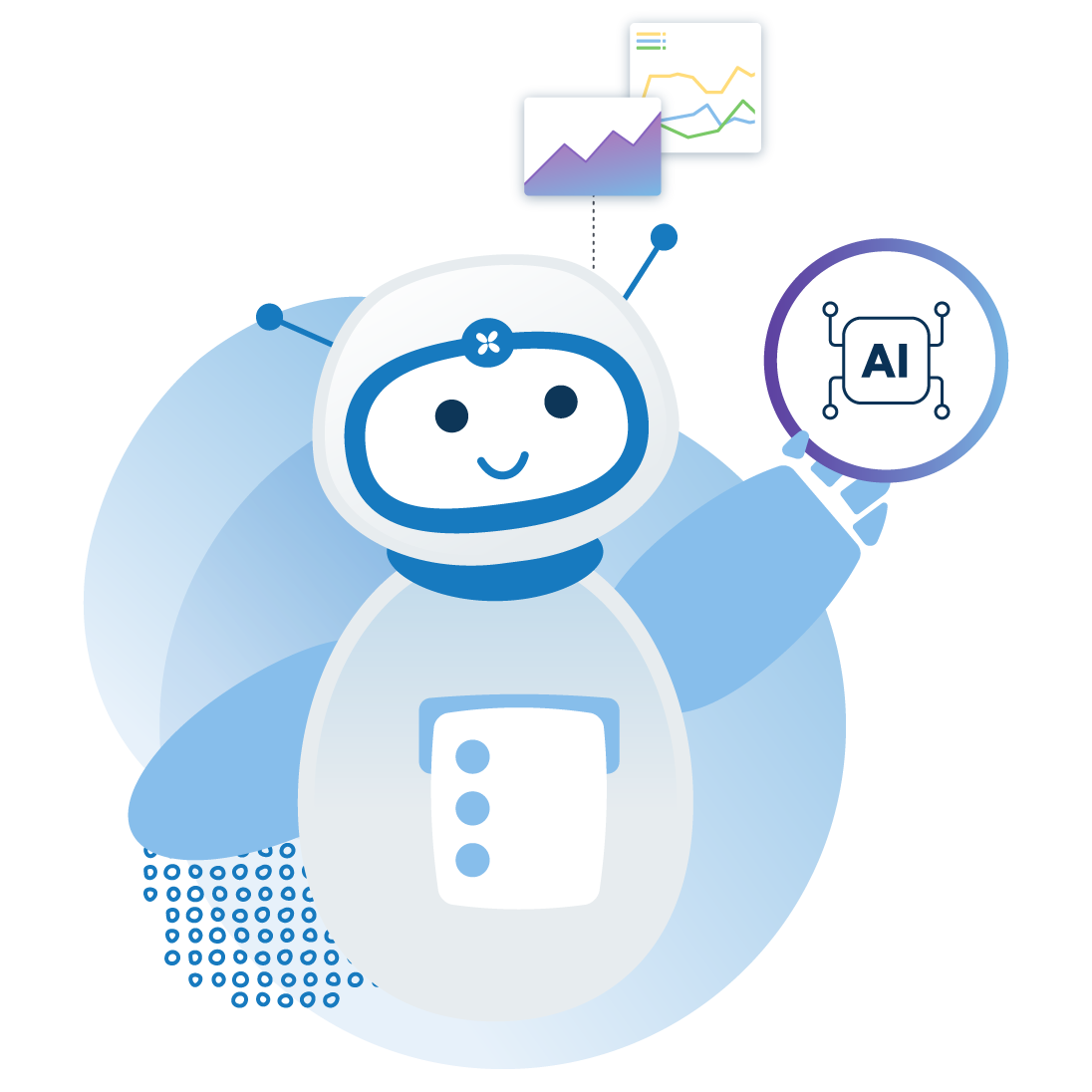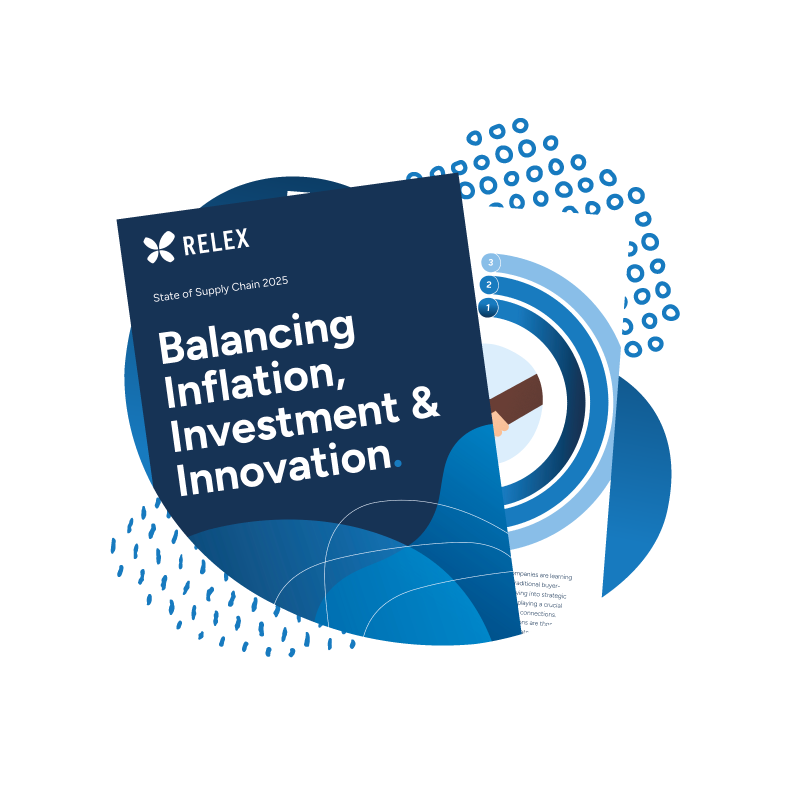Supply chain resilience in 2025: Balancing inflation, AI, and market volatility
Apr 30, 2025 • 7 min
Supply chains in 2025 are at a fascinating inflection point. For those of you working in retail, manufacturing, or distribution, you’re navigating supply chain resilience challenges that require much more nuanced thinking than ever before. The good news? We’ve evolved beyond the reactive, black-and-white approaches of recent years.
When looking at the research compiled in our 2025 State of Supply Chain Report three key forces are reshaping the supply chain landscape:
- Persistent inflation putting the squeeze on margins
- AI technologies that promise transformation (but come with implementation hurdles)
- The continuing rollercoaster of consumer demand and global events
What emerges is a clear picture: supply chain resilience in 2025 isn’t about choosing between efficiency and resilience, or between technology and human expertise, it’s about developing the capabilities to maintain equilibrium as conditions constantly evolve. Let’s unpack the key trends reshaping supply chains and why they are top of mind right now.
Persistent inflation and supply chain margin pressure
Inflation remains a stubborn reality in 2025 despite earlier predictions that it would fade. Why should supply chain leaders still care about inflation when it’s no longer making front-page headlines? Because it’s changing the rules of the game.
What makes inflation particularly significant right now is its compounding effect over time. We’re not seeing dramatic month-to-month price spikes anymore, but the cumulative impact of several years of above-target inflation has permanently altered consumer behaviors, supplier relationships, and margin structures. This isn’t a temporary disruption, but a structural shift that requires strategic responses.
Consider how consumers have adapted: they’ve become more price-conscious, more willing to switch brands, and more strategic in their purchasing. Our research shows that these behaviors are sticking even as headline inflation numbers moderate. This creates lasting pressure on both retailers and manufacturers to rethink their value propositions.
Meanwhile, inflation’s lasting impact has fundamentally shifted purchasing behaviors across market segments. Supply chain companies now face the dual challenge of maintaining competitive pricing while preserving already-compressed margins.

The private label revolution exemplifies these dynamics. Our research shows that 59% of retailers are expanding private label offerings primarily to capture higher margins in response to inflation. Retailers have discovered that private brands not only protect margins but also give them greater control over their supply chains, which is a critical advantage when managing inflationary pressures.
Meanwhile, manufacturers are finding they must continually innovate not just to grow, but simply to maintain their current market positions. In fact, 70% of CPG manufacturers have increased trade promotions and discount strategies to remain competitive against the growing threat of private labels.
What separates the leaders from the laggards is how they’re using this inflationary environment to drive transformative change. Forward-thinking organizations are leveraging advanced analytics to identify precise opportunities for improvement, rethinking product design from first principles, and using inflation as the catalyst to drive changes that might otherwise face organizational resistance.
AI implementation: Promise and challenges in supply chain management
Let’s dive into what’s happening with AI in supply chains—a space that’s evolved dramatically in 2025. What makes this moment particularly interesting is the shift from hype to practical implementation, and the surprising ways companies are integrating AI into their operations to enhance supply chain resilience.

Why does AI matter so much? Because we’re finally seeing genuine transformation rather than incremental improvement. The most forward-thinking organizations are using AI not just to do the same things faster, but to fundamentally reimagine what’s possible in supply chain management.
Perhaps the most telling trend is how AI is being integrated with traditional automation. Rather than viewing these as separate technologies, companies are creating hybrid systems where AI handles complex decision-making while conventional automation manages physical operations. Our research reveals a significant shift: traditional automation adoption has declined from 40% to 29%, while generative AI investment has surged to 60%. This isn’t an “either/or” proposition between automation and generative AI but a more sophisticated “and/both” approach.
But what are organizations actually doing with this technology? They’re prioritizing clear business outcomes: 60% are focusing on supply chain and inventory optimization, 58% are investing in e-commerce capabilities, and 43% are concentrating on data-driven decision-making. While these objectives aren’t new, the AI-powered approaches to achieving them represent a quantum leap forward.
Of course, challenges remain. The implementation gap between aspiration and execution continues to frustrate many organizations. Finding qualified talent remains difficult for 44% of companies, 43% face budget constraints, and 39% struggle with data quality issues. Yet these barriers are creating an interesting divergence in the market—those who overcome them are pulling dramatically ahead of competitors.
The most successful implementations share common characteristics: they start with clear business problems rather than technology solutions, they focus on building solid data foundations before attempting advanced analytics, and they create cross-functional teams that blend technical and domain expertise. Most importantly, they prioritize quick wins to build momentum and fund more ambitious initiatives.
Navigating volatility in consumer demand and global events
Remember when “unprecedented” was the word of the year? In 2025, volatility has become the new normal in supply chains. What makes this particularly significant now is that companies have moved beyond reactive responses to develop systematic approaches for thriving amid uncertainty.
Why should supply chain leaders care about volatility today? Because it’s no longer just about surviving disruptions, it’s about turning them into competitive advantages. Organizations that can sense and respond to volatility faster than competitors are strengthening their supply chain resilience, capturing market share, building customer loyalty, and protecting margins even as conditions shift.
The nature of volatility has evolved in fascinating ways. Consumer demand patterns have become increasingly unpredictable, with 52% of retailers citing consumer demand volatility as their most significant challenge, influenced by everything from social media trends to extreme weather events. This unpredictability makes forecasting increasingly difficult and puts pressure on inventory management systems. Extreme weather events, for instance, can create overnight demand surges that traditional forecasting methods simply can’t anticipate.
What’s particularly interesting is how companies are building resilience into their operations. Rather than simply maintaining higher inventory levels across the board (a costly approach), forward-thinking organizations are developing targeted strategies. We’ve seen a striking 14% year-over-year increase in companies building strategic inventory buffers—rising from 2024 to 2025.
They’re selectively increasing safety stock for critical components while maintaining lean practices elsewhere. They’re diversifying supplier bases while simultaneously deepening relationships with strategic partners.

Digital capabilities have become essential to these efforts. Real-time visibility tools, scenario modeling technologies, and predictive analytics allow companies to anticipate disruptions and develop response plans before problems materialize. This transforms resilience from a reactive stance to a proactive strategy.
Perhaps most significant is the evolution in how social media influences demand patterns. The unpredictable nature of viral content and influencer endorsements has fundamentally changed planning approaches. Leading organizations are integrating social listening directly with supply chain planning systems, allowing for early detection of emerging trends before they impact sales. This connection between digital signals and physical operations represents a new frontier in supply chain management.
Collaboration has also evolved from a relationship nicety to a business necessity. Our research quantifies the substantial costs of poor collaboration—lost sales, increased operational costs, and stockouts. The most resilient supply chains are those where partners share data transparently, align incentives, and jointly develop response plans to volatility.
The balanced approach to supply chain resilience
The companies pulling ahead aren’t those making dramatic bets on single strategies— they’re the ones mastering the delicate balance between competing priorities to achieve true supply chain resilience. They’re finding the sweet spot where resilience meets efficiency, where technology enhances rather than replaces human expertise, and where standardization provides structure without sacrificing the flexibility needed to respond to market dynamics.
For supply chain leaders navigating today’s challenges, the implications are profound. Success no longer comes from choosing the right side of competing priorities but from refusing to accept that these priorities must compete at all. The organizations that will thrive in coming years are those developing the capabilities, partnerships, and strategies to maintain this balance even as conditions continue to evolve.
Bottom line? The supply chain game is changing fast in 2025, and companies that find that sweet spot between cutting-edge AI and real-world practicality are crushing it. Want more detailed findings? Discover how leading companies are achieving supply chain resilience in our full report: “State of Supply Chain 2025: Balancing Inflation, Investment & Innovation“.

We talked to over 500 retail and manufacturing leaders to find out what’s actually working (and what’s not). Whether you’re just starting your supply chain makeover or looking to level up your existing strategy, this report has got you covered with insights you can actually use. Grab your copy now and see what’s driving success in today’s supply chain landscape!



